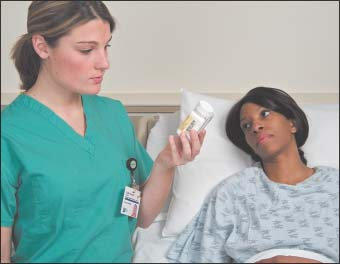Oral Drug Administration
Because oral administration is usually the safest, most convenient, and least expensive method, most drugs are administered by this route. Drugs for oral administration are available in many forms: tablets, enteric-coated tablets, capsules, syrups, elixirs, oils, liquids, suspensions, powders, and granules. Some require special preparation before administration, such as mixing with juice to make them more palatable; oils, powders, and granules most often require such preparation.
Sometimes oral drugs are prescribed in higher dosages than their parenteral equivalents because after absorption through the GI system, they are immediately broken down by the liver before they reach the systemic circulation.
Elder Alert
Oral dosages normally prescribed for adults may be dangerous for elderly patients.
Oral administration is contraindicated for unconscious patients; it may also be contraindicated in patients with nausea and vomiting and in those unable to swallow.
Equipment
Patient’s medication record and chart ▪ prescribed medication ▪ medication cup ▪ Optional: appropriate vehicle, such as jelly or applesauce, for crushed pills (commonly used with elderly patients), and juice, water, or milk for liquid medications; drinking straw; mortar and pestle for crushing pills; pill-cutting device for scored tablets.
Implementation
Avoid distractions and interruptions when preparing and administering medication to prevent medication administration errors.1
Compare the medication label to the order in the patient’s medical record (as shown below).1

Verify that the medication hasn’t expired and that no contraindications exist.
Visually inspect the medication for any loss of integrity.2
Verify that the medication is being administered at the proper time, in the prescribed dose, and by the correct route to reduce the risk of medication errors.2
Discuss any unresolved concerns about the medication with the patient’s doctor.2
If the patient is receiving the medication for the first time, teach the patient about significant adverse reactions or other concerns related to the medication.2

Stay updated, free articles. Join our Telegram channel

Full access? Get Clinical Tree


Get Clinical Tree app for offline access
